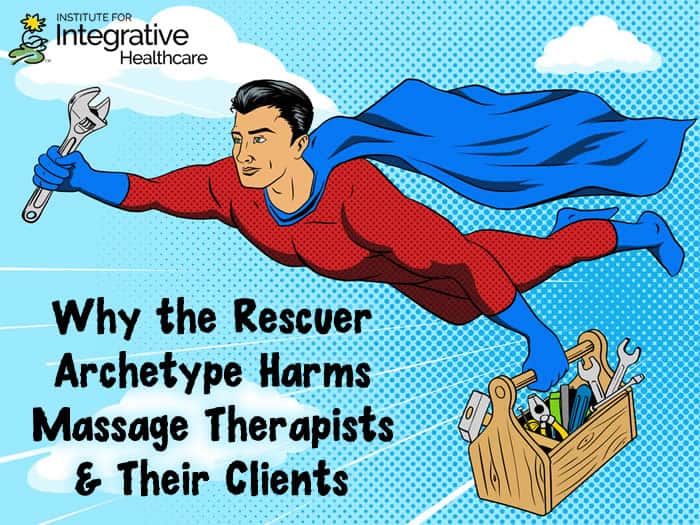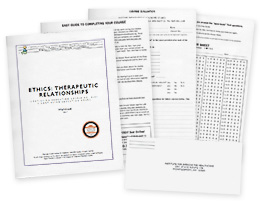

The ambition to be a massage therapist is typically rooted in a sincere desire to help people. While helping people may be at the root of a healthcare provider’s profession, it can be a detriment if the therapist feels responsible for a person’s recovery.
Having compassion for others can easily be confused with taking responsibility to help them. In some instances, joy derived from helping others can be a manifestation of attempting to rescue them – a distinctly different motivation. Unfortunately, therapists attempting to rescue their clients often end up hurting themselves and struggling with a rocky practice.
Being aware of the rescuer archetype can help massage therapists recognize when this model applies to them, a recognition that can prompt introspection and a more balanced approach towards healing.
What Is the Rescuer Archetype?
A prevalent fixture in many therapeutic relationships, the rescuer archetype describes a desire to be a hero and assume responsibility for taking away other people’s pain and suffering.
Unfortunately, therapists who don’t realize the part they play in this common pattern risk great disappointment, frustration and disillusionment with their professional and personal lives.
Massage therapists are especially at risk of falling into the role of rescuer:
- Expecting relief, clients seek out massage therapists when they are in pain or stressed.
- Regarded as experts in the human body, massage therapists are often recruited to fix somatic ailments and give much-needed advice.
- Massage therapists may feel uncomfortable when their clients are in pain (physical or emotional), often feeling responsible for rescuing clients from their struggles.
7 Signs a Massage Therapist May Be Taking on the Role of Rescuer
- Feeling obliged to heal clients – often with a sense of urgency.
- Being tempted to work too hard, too long, or too deep to produce results – despite what is appropriate for the client.
- Feeling like a failure if the desired changes with a client do not occur.
- Making special and ongoing exceptions for a client that is against usual policy.
- Feeling overly responsible for a client.
- Making people feel better boosts the therapist’s sense of self-worth.
- Bending over backwards to help a client, only to end up feeling unappreciated or taken advantage of.
Taking Responsibility
Recognizing that you may be fulfilling the rescuer archetype is the first step in switching to a more healthful healing pattern. The next step is acknowledging its psychological origins.
Rescuers often see themselves as helpers or caretakers. Usually originating during early childhood psychological development, these individuals have an unconscious need to rescue others in order to feel vital and important.
The key to breaking this chain is to learn how to feel vital and important without requiring the dependence of others.
You Are Not Responsible for Other People’s Choices
Following is a variation of the story shared among social workers to help them see if they fit into the trap of rescuing others.
A person stops a man on the street, asking directions to some well-known location. The man replies with the instructions, “At the end of this block, make a right turn.”
The person thanks the instruction-giver and continues down the block and turns left.
The man calls out “You are going the wrong way – I said turn right!”
The person responds “I heard you; I’m not ready to go there now.”
Although this may seem a far way off from administering massage therapy, the lesson is clear; you can offer your services, but you are not responsible for other people’s choices.
More on Responsibility
At first, the rescuing massage therapist may appear to be doing a great deal of good for their clients. However, this dynamic can quickly chip away at the well-being of both the practitioner and the client.
For the practitioner, the consistent violation of boundaries and unrealistic expectations lead to frustration, burn-out and ineffective therapy.
For the client, the dependency encouraged by their therapist feeds their neediness and disempowerment.
Balanced Therapeutic Relationships
The key to maintaining balanced therapeutic relationships lies in sticking to professional boundaries and being cognizant of where responsibility is taken.
Clients who view themselves as victims and look for someone to rescue them from their pain assume no responsibility in their struggle. Likewise, therapists who view their clients as victims, and take responsibility for healing them foster co-dependence.
The pattern is clearly unhealthy:
- The more a therapist engages in rescuing clients, the less self-responsibility is taken by the ones they care for.
- The less responsibility clients take in their own healing process, the more they seek rescuing.
- The more a therapist participates in rescuing, the more their self-worth is dictated by others.
- The more dependent a therapist becomes on rescuing, the more professional boundaries get crossed.
Conclusion
The solution for massage therapists locked into the rescue archetype is not simple. Upon recognizing this unhealthy pattern, the practitioner’s real work begins – learning how to feel vital and important without accolades from others, becoming comfortable in sticking to professional boundaries, and understanding that clients must take responsibility for their own healing process.
Wanting to help others is a wonderful gift that most bodyworkers possess. This desire can co-exist within healthy professional relationships, but massage therapists must figure out how to maintain that motivation while relinquishing responsibility for those who seek their help.
In doing so, the therapist gives the best treatment and advice they can without being responsible for the outcome. On the other hand, the client is left to choose whether they turn right or left, giving them the ultimate control over their own wellness.












